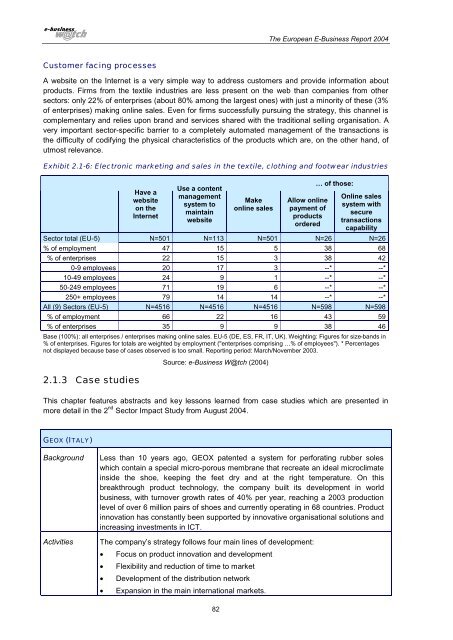The European e-Business Report 2004 - Berlecon Research GmbH
The European e-Business Report 2004 - Berlecon Research GmbH
The European e-Business Report 2004 - Berlecon Research GmbH
You also want an ePaper? Increase the reach of your titles
YUMPU automatically turns print PDFs into web optimized ePapers that Google loves.
<strong>The</strong> <strong>European</strong> E-<strong>Business</strong> <strong>Report</strong> <strong>2004</strong>Customer facing processesA website on the Internet is a very simple way to address customers and provide information aboutproducts. Firms from the textile industries are less present on the web than companies from othersectors: only 22% of enterprises (about 80% among the largest ones) with just a minority of these (3%of enterprises) making online sales. Even for firms successfully pursuing the strategy, this channel iscomplementary and relies upon brand and services shared with the traditional selling organisation. Avery important sector-specific barrier to a completely automated management of the transactions isthe difficulty of codifying the physical characteristics of the products which are, on the other hand, ofutmost relevance.Exhibit 2.1-6: Electronic marketing and sales in the textile, clothing and footwear industriesHave awebsiteon theInternetUse a contentmanagementsystem tomaintainwebsiteMakeonline salesAllow onlinepayment ofproductsordered… of those:Online salessystem withsecuretransactionscapabilitySector total (EU-5) N=501 N=113 N=501 N=26 N=26% of employment 47 15 5 38 68% of enterprises 22 15 3 38 420-9 employees 20 17 3 --* --*10-49 employees 24 9 1 --* --*50-249 employees 71 19 6 --* --*250+ employees 79 14 14 --* --*All (9) Sectors (EU-5) N=4516 N=4516 N=4516 N=598 N=598% of employment 66 22 16 43 59% of enterprises 35 9 9 38 46Base (100%): all enterprises / enterprises making online sales. EU-5 (DE, ES, FR, IT, UK). Weighting: Figures for size-bands in% of enterprises. Figures for totals are weighted by employment ("enterprises comprising … % of employees"). * Percentagesnot displayed because base of cases observed is too small. <strong>Report</strong>ing period: March/November 2003.2.1.3 Case studiesSource: e-<strong>Business</strong> W@tch (<strong>2004</strong>)This chapter features abstracts and key lessons learned from case studies which are presented inmore detail in the 2 nd Sector Impact Study from August <strong>2004</strong>.GEOX (ITALY)BackgroundActivitiesLess than 10 years ago, GEOX patented a system for perforating rubber soleswhich contain a special micro-porous membrane that recreate an ideal microclimateinside the shoe, keeping the feet dry and at the right temperature. On thisbreakthrough product technology, the company built its development in worldbusiness, with turnover growth rates of 40% per year, reaching a 2003 productionlevel of over 6 million pairs of shoes and currently operating in 68 countries. Productinnovation has constantly been supported by innovative organisational solutions andincreasing investments in ICT.<strong>The</strong> company’s strategy follows four main lines of development:• Focus on product innovation and development• Flexibility and reduction of time to market• Development of the distribution network• Expansion in the main international markets.82
















